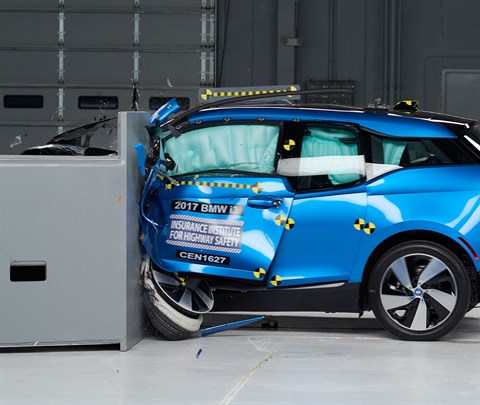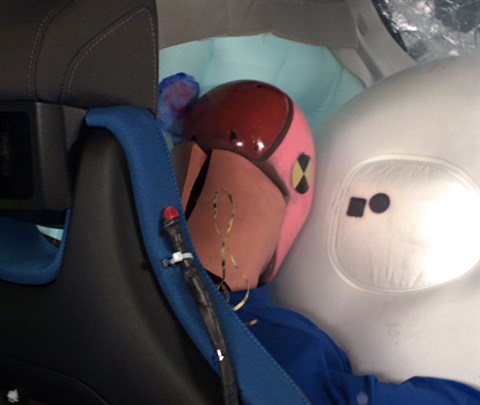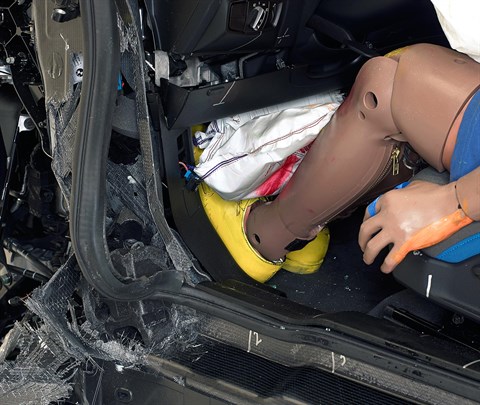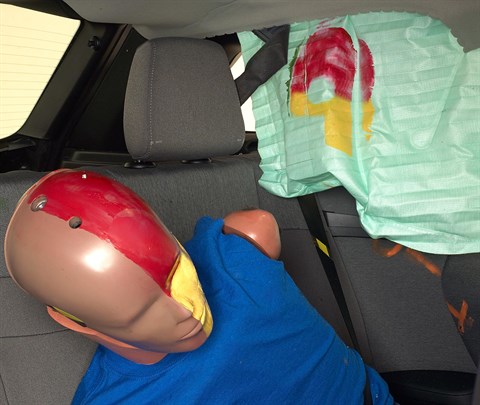Small overlap front: driver-side
Rating applies to 2017-21 models
Tested vehicle: 2017 BMW i3 4-door
The BMW i3 was introduced in the 2014 model year. The car is a plug-in battery-electric vehicle with an optional 2-cylinder gasoline engine "range extender" to assist in charging the battery. The EPA city and highway values listed below are based on a comparison of the energy content of a kWh of electricity vs. a gallon of gasoline. The battery capacity and weight of the car were increased beginning with the 2017 model year.
| Evaluation criteria | Rating |
|---|---|
| Structure and safety cage | |
| Driver injury measures | |
| Head/neck | |
| Chest | |
| Hip/thigh | |
| Lower leg/foot | |
| Driver restraints and dummy kinematics | |

Action shot taken during the small overlap frontal crash test.

The dummy's position in relation to the door frame, steering wheel, and instrument panel after the crash test indicates that the driver's survival space was maintained very well.

The seat belt and airbags worked well together to keep the head from coming close to any stiff structure or outside objects that could cause injury. Deceleration was so gradual in this test that the dummy's head never quite reached the frontal airbag.

The driver's space was maintained well, and risk of injuries to the dummy's legs and feet was low.
Moderate overlap front: original test
Rating applies to 2017-21 models
Tested vehicle: 2017 BMW i3 4-door
The BMW i3 was introduced in the 2014 model year. The car is a plug-in battery-electric vehicle with an optional 2-cylinder gasoline engine "range extender" to assist in charging the battery. The EPA city and highway values listed below are based on a comparison of the energy content of a kWh of electricity vs. a gallon of gasoline. The battery capacity and weight of the car were increased beginning with the 2017 model year.
| Evaluation criteria | Rating |
|---|---|
| Overall evaluation | |
| Structure and safety cage | |
| Driver injury measures | |
| Head/neck | |
| Chest | |
| Leg/foot, left | |
| Leg/foot, right | |
| Driver restraints and dummy kinematics | |

Action shot taken during the moderate overlap frontal crash test.

The dummy's position in relation to the steering wheel and instrument panel after the crash test indicates that the driver's survival space was maintained very well.

Smeared greasepaint indicates where the dummy's head contacted the side curtain airbag during rebound.

The driver's space was maintained well, and risk of injuries to the dummy's legs and feet was low.
Side: original test
Rating applies to 2017-21 models
Tested vehicle: 2017 BMW i3 4-door
The BMW i3 was introduced in the 2014 model year. The car is a plug-in battery-electric vehicle with an optional 2-cylinder gasoline engine "range extender" to assist in charging the battery. The EPA city and highway values listed below are based on a comparison of the energy content of a kWh of electricity vs. a gallon of gasoline. The battery capacity and weight of the car were increased beginning with the 2017 model year.
| Evaluation criteria | Rating |
|---|---|
| Overall evaluation | |
| Structure and safety cage | |
| Driver injury measures | |
| Head/neck | |
| Torso | |
| Pelvis/leg | |
| Driver head protection | |
| Rear passenger injury measures | |
| Head/neck | |
| Torso | |
| Pelvis/leg | |
| Rear passenger head protection | |

View of the vehicle just after the crash test.

View of the vehicle after the crash with the front door removed, showing the side airbags and damage to the occupant compartment.

Smeared greasepaint shows where the driver dummy's head was protected from being hit by hard structures by the side airbags.

Smeared greasepaint shows where the rear passenger dummy’s head was protected by the side airbag.
Roof strength
Rating applies to 2017-21 models
Tested vehicle: 2017 BMW i3 4-door
| Overall evaluation | |
|---|---|
| Curb weight | 2,920 lbs |
| Peak force | 13,772 lbs |
| Strength-to-weight ratio | 4.72 |
Head restraints & seats
Seat type: Manual cloth seat
| Overall evaluation | |
|---|---|
| Dynamic rating | |
| Seat/head restraint geometry |
About the head restraint & seat test
Currently, IIHS tests apply only to front seats.
Front crash prevention: vehicle-to-vehicle
Child seat anchors
Rating applies to 2017-21 models
| Evaluation criteria | Rating |
|---|---|
| Overall evaluation | |
| Vehicle trim | base |
| Seat type | cloth |
This vehicle has 2 rear seating positions with complete child seat attachment (LATCH) hardware.
| Evaluation criteria | Rating |
|---|---|
| Overall evaluation | |
| Vehicle trim | base |
| Seat type | cloth |
| Rating icon | Rating |
|---|---|
| G | Good |
| A | Acceptable |
| M | Marginal |
| P | Poor |
| Seating positions that rely on borrowed lower anchors or have only a tether anchor available are not rated. | |
thether anchor symbol | Tether anchor |
lower anchor symbol | Lower anchors |
| Lower anchor(s) can be borrowed from adjacent positions(s) | |
| No hardware available |
Details by seating position
| Position | Rating |
|---|---|
| 1 | |
| Tether anchor | |
| easy-to-find location | |
| other hardware could be confused for anchor | |
| Lower anchors | |
| not too deep in seat | |
| not too much force needed to attach | |
| difficult to maneuver around anchors | |
| 3 | |
| Tether anchor | |
| easy-to-find location | |
| other hardware could be confused for anchor | |
| Lower anchors | |
| not too deep in seat | |
| not too much force needed to attach | |
| difficult to maneuver around anchors |
